Yoga is not all headstands and extreme backbends. You don’t have to be naturally flexible to start practicing yoga. You don’t have to be strong. You don’t have to be skinny. You don’t even have to be mobile. Yoga is for anyone and everyone, and is extremely diverse. In fact, it’s not all about asanas (poses). If you practice yogic breath and relaxation, you are practicing yoga. Everyone, from people with injuries or recovering from illness to people in wheelchairs or severe arthritis can reap the incredible benefits of yoga…
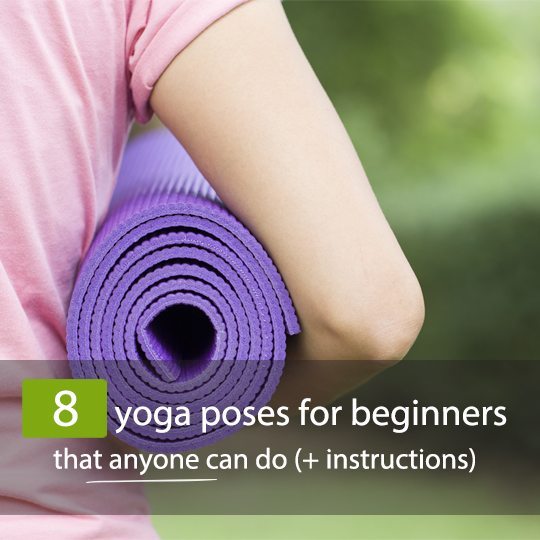
Benefits Of Yoga That Anyone Can Reap
Unlike many forms of exercise that just focus on the physical, yoga takes an overall approach to wellness, through mental and spiritual, as well as physical, practice. Breath, relaxation, diet and lifestyle are all important aspects of this ancient system. Although yoga has been around for thousands of years in India, and was fobbed off for a long time in the West as alternative and unproven, the last few decades have seen scientists, medical doctors and fitness experts embrace yoga as a healing, beneficial practice. Some of the proven benefits of a regular yoga practice include:
- Increased flexibility
- More strength
- Better balance
- Improved posture
- Toned muscles
- Healthier joints
- Less stress and anxiety
- Better sleep
- Calmer mind
- Improved lymphatic system
- Improved respiratory function
- Better circulation
- More energy
- Weight loss
- Lower blood pressure and cholesterol
- Stronger immune system
- Improved memory
- Better mood
- Better digestion
- Increased bone strength
- Better sex
And, to be honest, there are plenty more benefits! Surely you’re intrigued now…

Yoga Poses For Beginners (That Anyone Can Do)
These are all beginners poses, but if you do have an injury or illness, or are in a wheelchair, then skip the ones you can’t do and always seek advice before starting any exercise routine. If you are a complete beginner, it’s a great idea to join a beginners’ class, and if you are dealing with a particularly significant injury or illness, and would prefer private lessons, a yoga therapist is a great option to get you started. Certain classes, like restorative yoga, can often accommodate certain injuries, however, if, for example, you are in a wheelchair or largely immobile, a yoga therapist might be the best option.

Pranayama
Before we get to the physical asanas, let’s look at one of the most important aspects of yoga – breath. There are lots of different pranayama (breath) techniques in yoga, with the most common being ujjayi, which is the one practiced during asanas and sequences. Ujjayi, which means ‘victorious’, is designed to be energizing and relaxing at the same time when practiced correctly. It should be long and smooth, and sounds like rolling ocean waves. This is accomplished by slightly constricting the throat, creating a subtle resistance to the passage of air. From there, you gently inhale the air, as if you are drawing it all the way into the bottom of your belly, and then gently pushing it out on an exhalation. The inhale and exhale should be the same or similar lengths and will ensure you oxygenate your whole body, instead of taking those shallow breaths that become common as we age, become busy and deal with everyday stress. Don’t expect to have the perfect ujjayi breath on your first try – it takes time, and takes even longer to get used to practicing it during an asana sequence. Just keep practicing!
Joint Release Series
This is a fantastic little sequence that releases, warms up and lubricates the joints. You can either practice in a seated position, like in the video, or modify it as you need to. For example, if you are in a wheelchair (and have been given the all-clear by your doctor to practice the joint release series), you can do it sitting in the chair or even do what you can lying down.
Mountain Pose (Tadasana)
This pose looks like you are just standing there, but there is actually a lot more going on than that. It is a very powerful pose that, when done correctly, can be grounding an energizing at the same time. To begin with, just get comfortable and stand up straight and tall. Roll your shoulders back and down and then let them relax into place. Allow your big toes to touch, with about an inch of space between your heels. Slightly tilt your tailbone down to lengthen the spine, and similarly, very subtly tuck your chin in to lengthen the top of the spine and the back of the neck. You will notice your abdominal muscles automatically become engaged when you elongate your spine. Lightly engage your thighs, lifting the knee caps and then practice a few rounds of ujjayi breath.

Standing Forward Bend (Uttanasana)
From mountain pose, bend forward with a flat back on an exhale, bending from the hips and leading with the heart (don’t curl forward with the shoulders, compressing your chest). Slightly bend your knees to begin with, especially if you haven’t warmed up, and focus on lengthening the front of the torso as you are folding forward. Depending on your natural flexibility, your hands might reach your thighs, shins, or the mat. If you can straighten your legs, then do so, but don’t force it if it is painful. Once you have reached down to the point you are going to hold, you can relax a little more, lengthening the back. If you can’t reach the mat or hold the backs of your ankles, then cross your forearms and hold your elbows. Your heels should be pressing firmly into the mat, with your seat bones lifting towards the ceiling. Try to relax in this pose as much as possible, noticing the release and stretch along the spine.
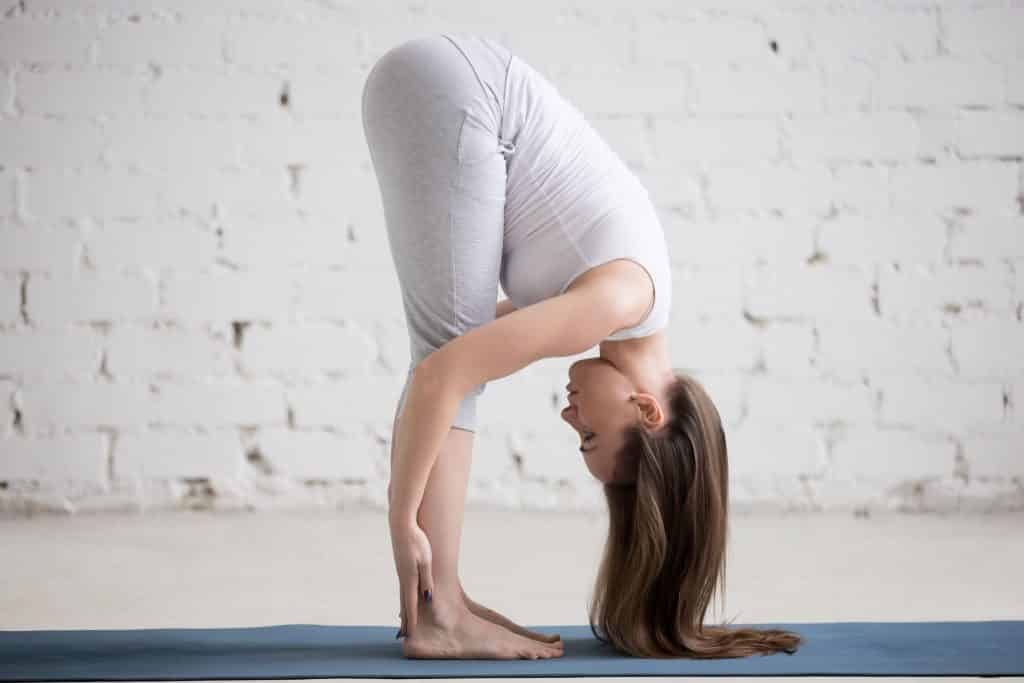
Equestrian Pose (Ashwa Sanchalanasana)
From forward bend, take your right leg back as far as possible, bending the left knee. Place the right knee down and place the fingers or palms down on the mat either side of your left foot. Open the chest and look forward or up. If you feel comfortable enough to release your hands from the mat, draw them up on an inhale, opening the chest even more and take a slight back bend if it feels good to do so. Hold for three to five breaths. Make sure you can feel a stretch at the top front of the right thigh and around the psoas muscle. Repeat with the left leg back for the same amount of breaths.
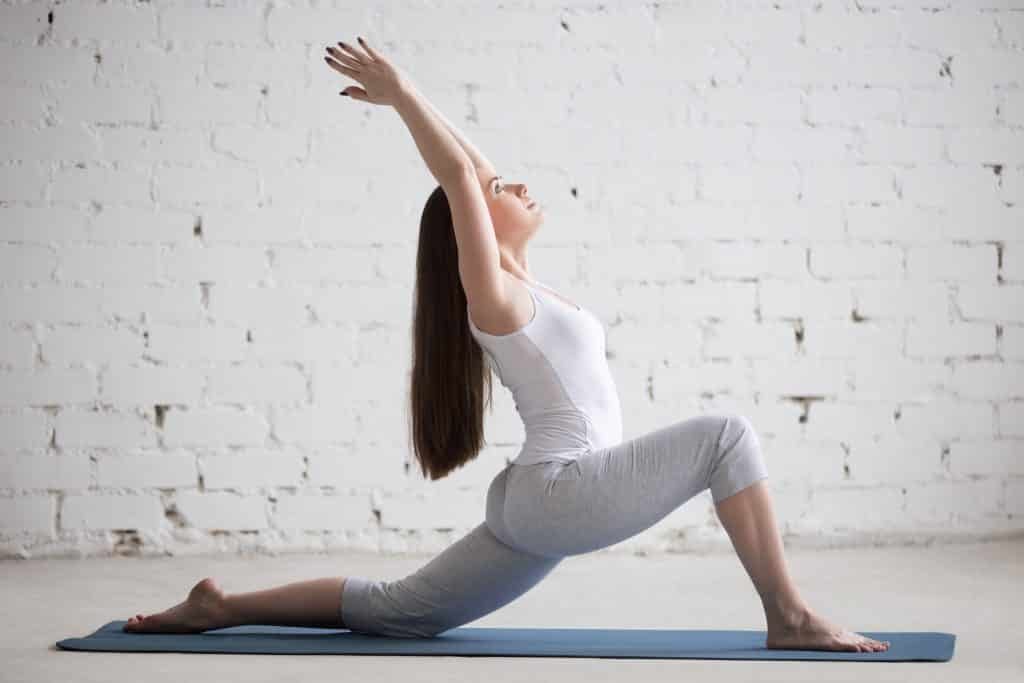
Plank Pose
This one takes a bit of strength and if you are particularly unfit or recovering from an illness, you might find it difficult, and need to add it to your practice later on. If you are a beginner with no injuries or illness, however, then you can practice it straight away. From either equestrian pose or forward bend, step one foot back and then the others, standing on the balls of your feet and your hands with your heels pushing towards the back of the room. Make sure your wrists are directly underneath your shoulders and your back is straight. Don’t let your buttocks drop down or lift up. To ensure you are straight, tighten your core and thigh muscles and make sure your buttocks is not pointing upwards. Breathe and hold this pose for a few breaths, increasing the time you hold it as you practice and gain more strength. If you have weak or injured wrists, you can practice plank pose on your forearms instead of your hands.
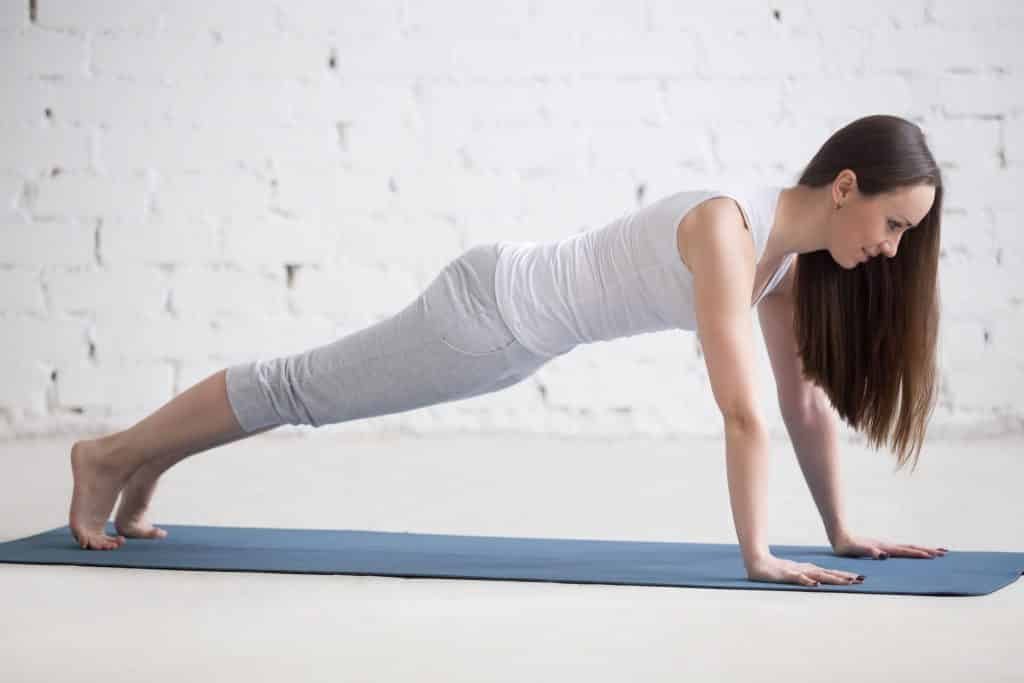
Cobra Pose (Bhujanga)
From plank pose, gently lower your knees to the ground and slowly lower your torso to the mat, keeping your elbows in by your sides. If you are skipping plank pose, start by lying on your belly. Release your feet so that the tops are on the mat and stretch your legs back. Place your hands, fingers spread, on the mat underneath your shoulders. Keeping your elbows by your sides, press the tops of your feet and thighs firmly into the mat, and, as you inhale, begin straightening your arms and lifting your chest off the floor. Move slowly and move to a height that is comfortable for your lower back – your elbows can be bent or straight. Keep your buttocks firm, but not completely hard and lift your pubis towards your naval. Release your shoulders back and down, away from your ears, but don’t push your ribs forward too much, because this will put excess strain on the lower back. Ensure you are distributing the backbend evenly along the whole spine, not collapsing into the lower back. Take a few breaths here.
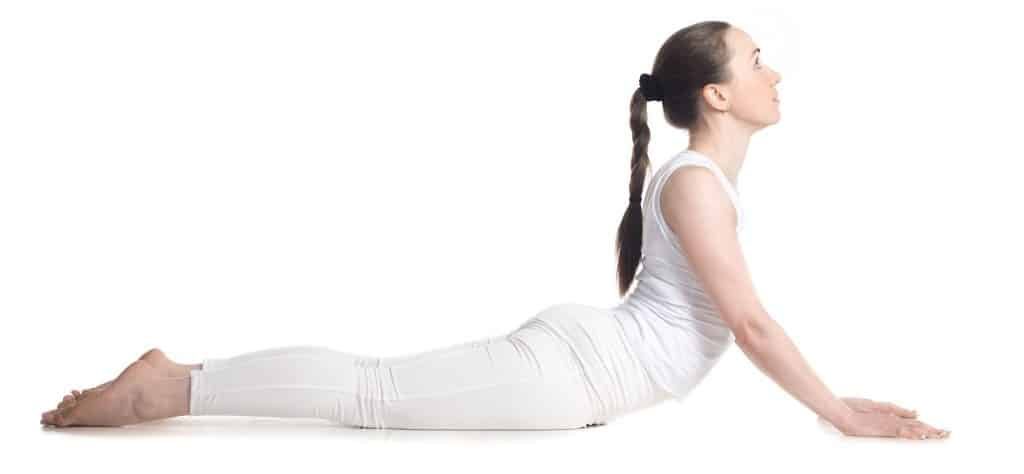
Downward Facing Dog (Adho Mukha Svanasana)
This is arguably the most important yoga asana in a sequence – especially in flow classes like vinyasa. From cobra pose, curl your toes underneath, keeping your palms firmly pressed into the mat with your fingers spread. As you exhale, lift your knees away from the floor, keeping them slightly bend with the heels off the mat. Lengthen your tailbone away from the back of your pelvis and lift your seat bones towards the ceiling. Push away from the mat with your hands, keeping your back straight and lifting your thighs up and back, pressing your heels towards the floor, but don’t worry about getting them to reach or straightening your knees as a beginner. Downward facing dog takes a lot of practice to get right. The main thing to begin with is getting the upper body into the correct position. Firm the outer arms and widen shoulderblades to flatten your upper back, drawing them towards your tailbone. Keep your head between your arms, looking back towards your legs, but don’t let your head and neck hang down.
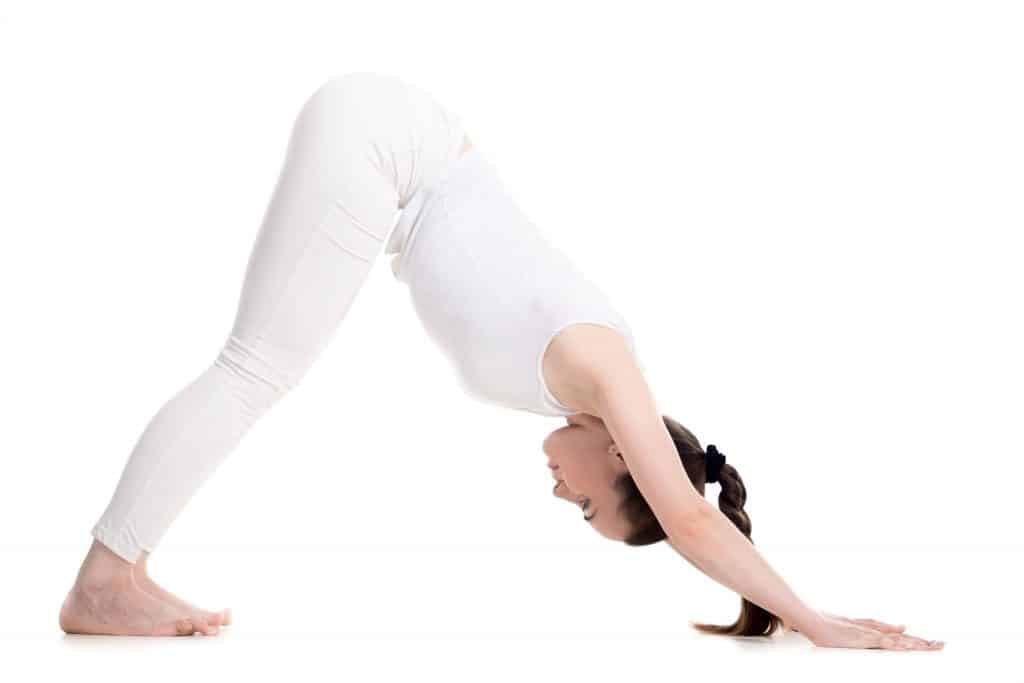
L-Shape (Against A Wall)
Inversions are important parts of yoga. This is a very basic inversion that anyone can do, and doubles as a restorative pose. It relaxes the body, stretches the back, reverses blood flow from your feet and therefore gives your heart a rest. You can practice this pose against any flat or smooth wall. To move into this pose, sit sideways next to the wall. Slightly lift the glute closest to the wall up against it a little and then slowly and gently lift your legs up against the wall and lay your back on the floor. Don’t worry if you aren’t perfectly against the wall, or if your legs are a little bent at the knees – again this all takes time. Release your arms to either side of your body with your palms facing up and close your eyes. Check in with yourself to see if you are holding any tension – especially around the shoulders, back or neck, and if you are, use your exhales to release it. Relax in this pose for at least a couple of minutes, noticing your feet becoming light.
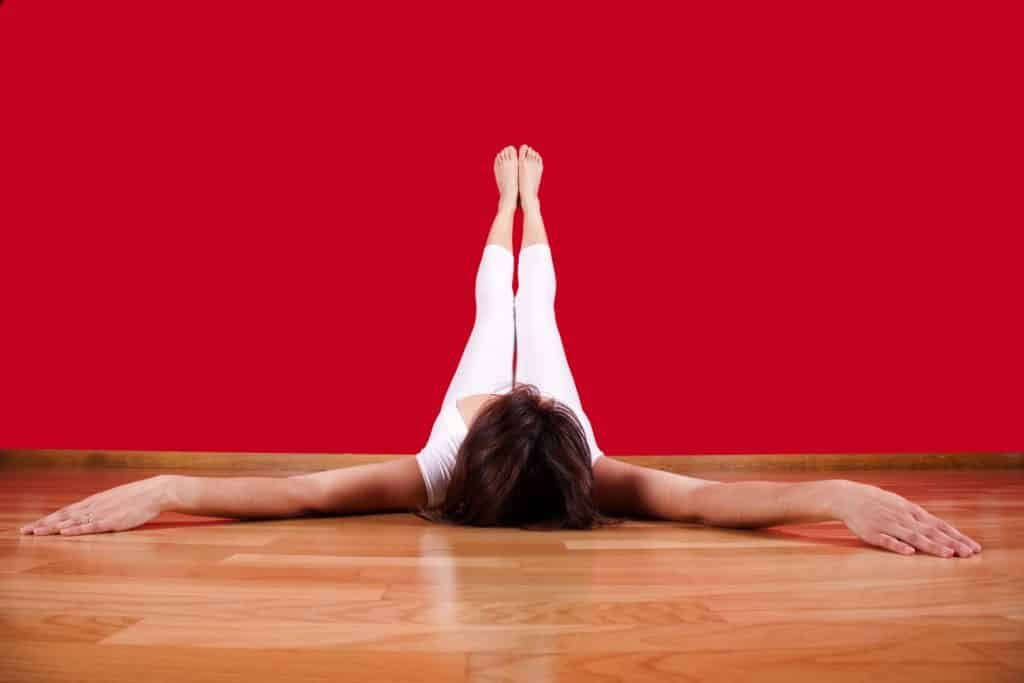
Universal Spinal Twist
This is another wonderful restorative pose that twists the spine, making it more comfortable for you to relax into corpse pose. It also releases any tension that may be left in the lower back or hips. Twisting poses like this are also great for digestion. Start on your back and bend your right knee on an inhale. Spread your arms out to either side, palms facing down. On an exhale, gently drop your bend knee to the left, twisting from the hips and spine. Keep both shoulders on the mat and turn your gaze towards the right. You should feel a deep stretch around your right hip and glute and around your spine, while your chest should feel nice and open. Stay in this pose for at least 10 breaths and then repeat in the other direction.
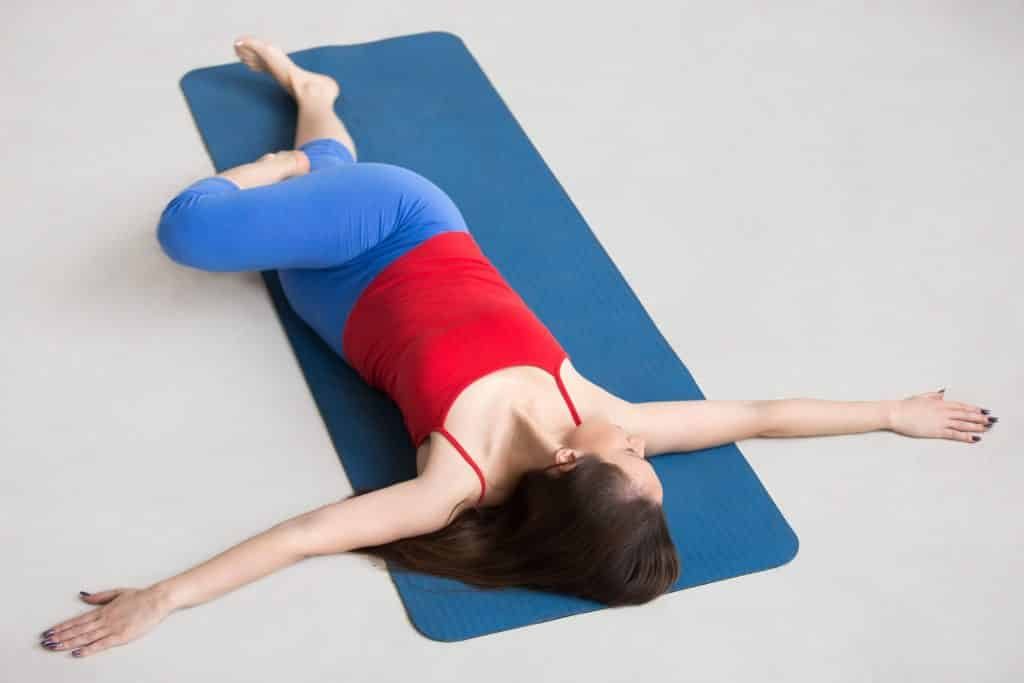
Surya Namaskar (Sun Salutation)
If you feel that you are able to turn some of these poses into a sequence, surya namaskar, or, sun salutations, are a great place to start, and are particularly beneficial in the mornings to wake up the body and kick-start digestion, metabolism, lymphatic movement, circulation and flexibility.
Always finish your yoga practice with restorative poses and relaxation. Relax in either corpse pose or meditate in easy pose (sitting cross-legged), allowing yourself some stillness and quiet in the mind.


